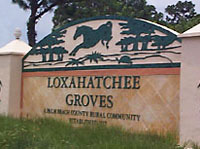The Loxahatchee Groves Town Council heard reports from most of its advisory committees, staff and consultants on Tuesday, May 7, with Town Engineer Larry Peters reporting that staff had put down more than 5,000 tons of rock on its dirt roads over the past year.
Peters, who supplied the council with a comprehensive written operations and maintenance report, said staff put down 900 tons of base rock just over the past week, equating to about 50 truckloads.
Councilwoman Laura Danowski said she was impressed to see new speed limit and “No Through Trucks” signs posted on town roads.
Councilwoman Phillis Maniglia, however, said she had seen and heard reports that the road rock was too coarse for equestrian traffic.
“We need to remember that we are an equestrian community, and when you put rock on the road, it has to be equine-friendly,” Maniglia said. “I’ve been seeing some huge rocks put on the road that I can’t imagine anyone would be able to pass on a horse.”
Peters said his crew is still in the first phase of topping the roads.
“We’re not finished,” he said. “There is another layer that goes on top of this rock. That’s only a base rock. There’s another step, [and] we’re not there yet.”
Peters added that town staff would do the second step as soon as it has the personnel to do it.
Mayor Robert Shorr asked specifically where the crew would be working this week.
“I know with the rains, you’re chasing your tails, but I saw they dropped a load on E Road,” Shorr said. “I know you’ve dropped hundreds of loads throughout the community, but if it’s not on somebody’s roads, they may not see the impact.”
Peters said he starts the week on Monday with a safety meeting.
“We’re pretty much up to date with all the safety issues,” Peters said. “Secondly, we go out and ride the roads, because in order to comply with your requests to at least grade the roads, the main lettered roads every Friday and again on Monday if possible, rain permitting, but last week alone, in one day, we put 900 tons of rock on North Road. For the entire period of time that we’ve been here, and we’ve been in control of the roads, we’ve placed more than 5,000 tons of base rock, so it’s being established, and everywhere we’ve had an opportunity to complete the job, there’s not any issues with water.”
Peters added that if given enough staff, he would be able to get all the roads done properly. He currently has a three-person crew working on roads with a fourth mowing equestrian trails and canal banks.
Maniglia pointed out that the OGEM (open-graded emulsified mix) roads that are now six years old have not been top-coated as they were supposed to have been and are breaking off on the sides. Peters said they were to have been sealed after five years, and that has not been done.
“F Road is deplorable,” Peters said. “I drove down it today, and I was embarrassed. Tomorrow we’re going to try some patching, but we just patch and patch. We should be doing some fixing instead of patching. We’re going to try an 800-square-yard repair. It’s basically about $22 a square yard. It’s very reasonable if we’re allowed to do it.”
Councilwoman Lisa El-Ramey asked if the contractor fixing the OGEM roads is the original contractor who put down the roads, and Peters said it was his understanding that there are only two companies that do it.
“One is from Tampa, and the other is from the Palatka area,” Peters said. “Yes, it’s the same person. The one in Tampa is too large to mess with us.”
El-Ramey asked about attempts Peters mentioned in his report about widening some of the OGEM roads to 20 feet, and Peters said some areas are not 20 feet, forcing one driver off the road.
“When they do so, generally there is standing water or there is a non-compacted berm, which causes a hole,” Peters said. “Then they jump back on the road, which causes it to become in disrepair. So, we can saw cut at 16 feet… or wherever it’s falling apart on the edge. We can dig down six inches and compact a base and put in six inches of millings, and those millings are free to us if we have our truck in line at midnight, so this could be a process, or we could get a contractor to do it.”
Maniglia asked about the grader operator taking portions of the berm and laying it down on the road, and Peters said it was intentional because the berms were getting too thick and the operator is trying to raise the level of the road so water does not stand on the canal side.
“We’re raising the road as much as a foot, so the berm gets smaller as we raise the road,” Peters said. “We can come back and fix the berms, but we have to fix the roads first and get it to drain… Most of the property is higher now than the road side, not the canal side, is higher now than the road, so there is no place for the water to go. If we raise it up, then the water goes onto the property where we put in proper drainage and swale.”
Peters added that the OGEM contractor is coming to the town on May 15 to evaluate the condition of the OGEM roads. He added that between now and then, he hopes to go to Jupiter Farms to look at OGEM roads there. “It is a solution,” he said. “It may not be the solution, but it is a solution.”
Councilman Dave DeMarois said after the financial report is given, the council may be able to find some money to redirect to operations and maintenance to fulfill its plans.








